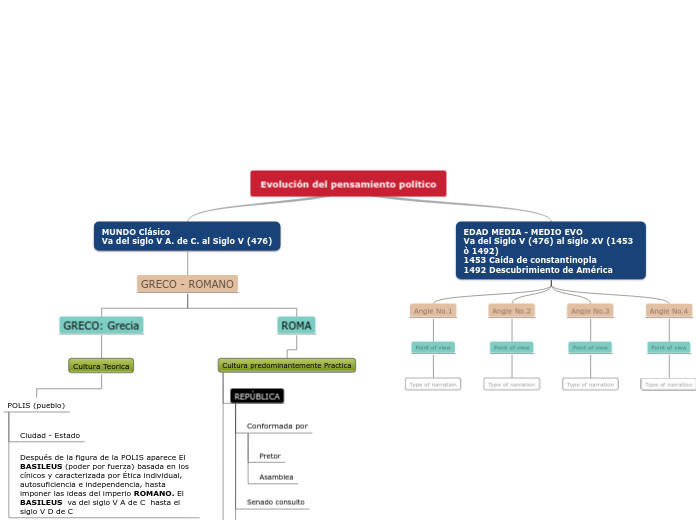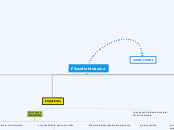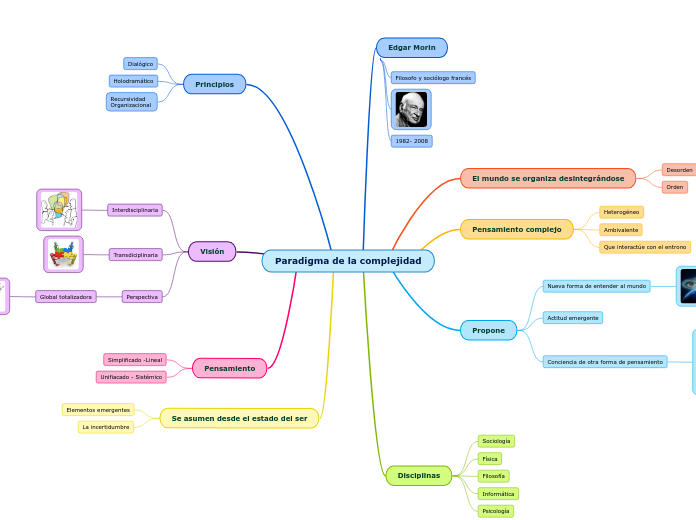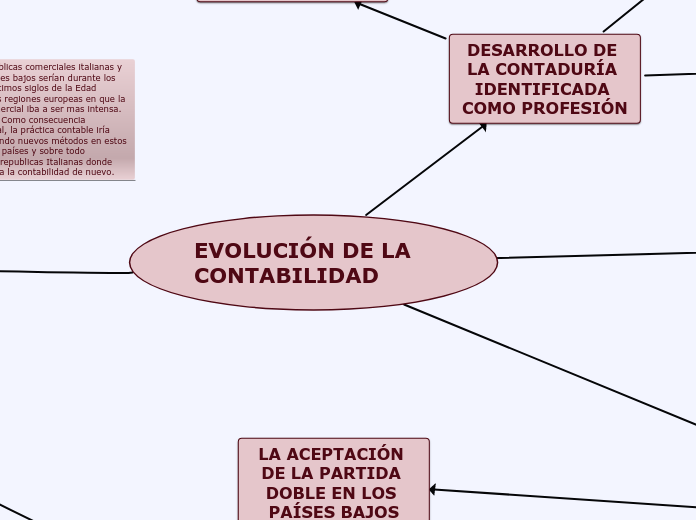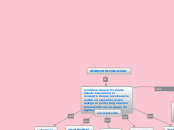Teoria de las ideas (objetivas, eternas y universales) Arquetipos
GRANDES FILOSOFOS DEL MUNDO CLÀSICO
Aristóteles
Platón
Antes de Cristo 427 al 347
Escribió
Las Leyes (Platón en la Vejez)
El Fedón
El Banquete
La República
No cree en la Democracia
Se le critica el "Determinismo social" (solo puede gobernar el sabio)
Socrates
Auto-gobierno
La virtud se aprende
El hombre conoce lo bueno y lo malo y escoge lo bueno
Sé que soy yo y no el otro
Conócete a ti mismo
Otros discipulos
Tenes
Antis
Diogenes
Siglo V A de C (323) Muerte de Alejandro Magno - Termina la época de la Antigua Gracia Inicia el periodo: HELENISTICO, HELENISMO o Periodo ALEJANDRINO
Siglo V A de C 323 Muerte de Alejandro Magno - Termina la época de la Antigua Gracia
Siglo V A de C (431 al 404) Guerra del Peloponeso
Texto escrito por TUCIDIDES Historia de la guerra del Peloponeso
Liga PELOPONESO (Liderada por Esparta)
VS
Liga DELOS (liderada por Atenas)
Siglo V: Democracia Directa Y el Modo de producción era el Esclavismo
Edad Moderna Siglo XV (1453 o 1492) al Siglo XVIII (1789)
FUNDAMENTOS ANTROPOLÓGICOS
POLÍTICA
TÉCNICA DE PODER, SE CONCENTRA EN LA CIUDAD Y EN LA FIGURA DEL "PRÍNCIPE"
SEGÚN MAQUIAVELO
SISTEMA NORMATIVO
Se retoman conceptos iusnaturalistas
AUNQUE ES UN CONCEPTO EVOLUTIVO, NORBERTO BOBBIO LO EXPLICA EN ESTE ESPACIO TEMPORAL
FUNDAMENTADO EN LA RACIONALIDAD. CON FUNDAMENTO EN LAS IDEAS DE TOMMAS HOBBES, JOHN LOCKE, ROUSSEAU SE HABLA DE CONTRACTUALISMO Y SEPARACIÓN DE PODERES
SISTEMA ECONÓMICO
FUNDAMENTADO EN LA INDUSTRIALIZACIÓN Y PRODUCCIÓN
PODER
SEGÚN ZYGMUNT BAUMAN
SE PASA DE GUARDABOSQUES A JARDINEROS
Desde la perspectiva de
Zygmunt Bauman, en el sentido que el poder del Estado se modela al papel del jardinero.
SECULARIZACIÓN DE LA POLITÍCA
SEGÚN THOMMAS HOBBES
CUESTIONA EL ESTADO DE NATURALEZA
SE HACE NECESARIO LA FIGURA DEL PACTO QUE CONFIGURA EL ESTABLECIMIENTO DEL ESTADO
TRANSFORMACIÓN SIMBÓLICA DE LA PERSONA
SUJETO - INDIVIDUO
EL INDIVIDUO COMO CENTRO DE LA SOCIEDAD
Se termina con la figura de siervo
CONOCIMIENTO
SE FUNDAMENTA EN LA RAZÓN
EMPIRISMO
LOCKE - HUME
MÉTODO INDUCTIVO
RACIONALISMO
DESCARTES - SPINOZA
MÉTODO DEDUCTIVO
TIEMPO
BASADO EN LA PRODUCCIÓN - CRONOLOGÍA
SE COMIENZA A VIVIR PARA TRABAJAR. SE ES "DEPENDIENTE" O "ESCLAVO" PARA PRODUCIR
DADO POR LA DINÁMICA MERCANTIL
CULTURALMENTE
ANTROPOCENTRISMO
RENACIMIENTO DURANTE LOS SIGLOS XV Y XVI, FUNDAMENTADO EN EL HUMANISMO
Donatello (1386-1466)
Leonardo Da Vinci (1452-1519)
Miguel Ángel (1475-1564)
Rafael Sanzio (1483-1520)
En este siglo V prevalece
En la POLIS La población estaba dividida en
Extranjeros o metecos
Los esclavos( 1/3 de la población)
Los ciudadanos que tenían derecho a la vida política y pública
El modo de producción es el ESCLAVISMO
Democracia directa (participan solo los de "arriba")
Aportaron instituciones cohasionantes
Immanuel Kant fusionó estos dos métodos y formulo IDEALISMOS TRASCENDENTAL
Evolución del pensamiento político
Type in the name of the multiple-perspectives text.
Example: Bridge to Terabithia by Katherine Paterson
EDAD MEDIA - MEDIO EVO Va del Siglo V (476) al siglo XV (1453 ò 1492) 1453 Caída de constantinopla 1492 Descubrimiento de América
Angle No.4
Decide on the fourth point of view
Type in the name of the last character whose perspective on the issue you are going to present.
Example: Leslie Burke, Jesse's new next-door neighbor, and best friend.
Point of view
Type in a relevant quote that highlights the character's point of view. Try to follow a citation format: author's name, chapter, and page.
Example: I can't get the poetry of the trees,' he said. She nodded. Don't worry,' she said. You will someday. He believed her.' (Paterson, 4. 24)
How is the viewpoint introduced in the story?
Choose an answer:
First person point of view - using the personal pronouns 'I' or 'we'Second person point of view - using the personal pronoun 'you'Third person point of view - using the third-person pronouns 'he', 'she' and 'they'Omniscient point of view - an all-seeing observer tells the story
Angle No.3
Whose character does the third point of view belong to?
Type in his/her name.
Example: Mr. Aarons, Jesse's father.
What does the character think, say or do that suggests their perspective on the issue?
Type in a quote and try to maintain the citation format.
Example: 'He would like to show his drawings to his dad, but he didn't dare. (...) He'd thought his dad would be pleased. He wasn't. What are they teaching in that damn school? he had asked.' (Paterson, 2.8)
What kind of narration introduces the viewpoint?
Choose an answer:
First person point of view - using the personal pronouns 'I' or 'we'Second person point of view - using the personal pronoun 'you'Third person point of view - using the third-person pronouns 'he', 'she' and 'they'Omniscient point of view - an all-seeing observer tells the story
Angle No.2
Decide on the second point of view
Name the character (it can either be the main character or one of the supporting characters) whose point of view you are presenting.
Example: Miss Edmunds, Jesse's music teacher.
Type in a quote that points out the character's position about the issue.
Try to follow a citation format: author's name, chapter, and page.
Example: 'She said he was unusually talented, and she hoped he wouldn't let anything discourage him.' (Paterson, 2. 8)
How is the viewpoint introduced in the story?
Choose an answer:
First person point of viewSecond person point of viewThird person point of viewOmniscient point of view
Angle No.1
Point of view
Type in a relevant quote that highlights the character's point of view towards
EDAD MEDIA - MEDIO EVO Va del Siglo V (476) al siglo XV (1453 ò 1492) 1453 Caída de constantinopla 1492 Descubrimiento de América.
Try following a citation format: author's name, chapter, and page.
Example: 'Jesse drew the way some people drank whiskey. (...) Lord, he loved to draw. (...) When he was in first grade, he told his father that he wanted to be an artist when he grew up.' (Paterson, 2. 7)
Type of narration
MUNDO Clásico Va del siglo V A. de C. al Siglo V (476)
Identify an important issue from the text that is being presented from different angles. Type it in.
Example: Jesse's drawing talent.
GRECO - ROMANO
Decide on the first point of view you are going to present.
Type in the name of the character (it can either be the main character or one of the supporting characters) whose point of view belongs to.
Example: Jesse Oliver Aarons, Jr., the main character of the novel, a fifth-grader living in a rural Southern area.
ROMA
Cultura predominantemente Practica
IMPERIO
Va desde 27 A.C. al 476 D. de C.
REPÚBLICA
Va desde 510 A.C. al 27 A.C.
Senado consulto
Conformada por
Asamblea
Pretor
GRECO: Grecia
Type in a relevant quote that highlights the character's point of view towards
MUNDO Clásico Va del siglo V A. de C. al Siglo V (476).
Try following a citation format: author's name, chapter, and page.
Example: 'Jesse drew the way some people drank whiskey. (...) Lord, he loved to draw. (...) When he was in first grade, he told his father that he wanted to be an artist when he grew up.' (Paterson, 2. 7)
Cultura Teorica
What type of narration introduces the viewpoint?
Choose an answer:
First person point of view - using the personal pronouns 'I' or 'we'Second person point of view - using the personal pronoun 'you'Third person point of view - using the third-person pronouns 'he', 'she' and 'they'Omniscient point of view - an all-seeing observer tells the story
POLIS (pueblo)
Después de la figura de la POLIS aparece El BASILEUS (poder por fuerza) basada en los cínicos y caracterizada por Ética individual, autosuficiencia e independencia, hasta imponer las ideas del imperio ROMANO. El BASILEUS va del siglo V A de C hasta el siglo V D de C
Ciudad - Estado
